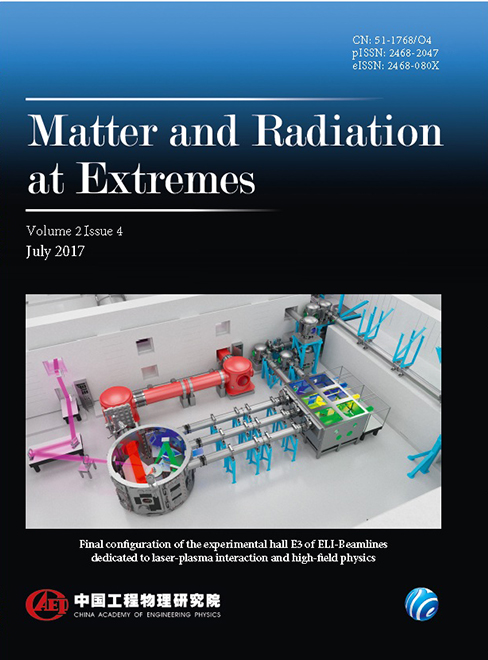
A sharp density increase (referred to as density incrustation) of the Au plasmas in the radiative cooling process of high-Z Au plasmas confined by low-Z CH plasmas is found through the radiative hydrodynamic simulations. The temperature of Au plasmas changes obviously in the cooling layer while the pressure remains constant. Consequently, the Au plasmas in the cooling layer are compressed, and the density incrustation is formed. It is also shown that when the high-Z plasma opacity decreases or the low-Z plasma opacity increases, the peak density of the density incrustation becomes lower and the thickness of the density incrustation becomes wider. This phenomenon is crucial to the RayleigheTaylor instability at the interface of high-Z and low-Z plasmas, since the density variation of Au plasmas has a considerable influence on the Atwood number of the interface.
Self-consistent calculations of energy loss for a Ga ion moving in hot Au plasmas are made under the assumption of wide ranges of the projectile energy and the plasma temperature with all important mechanisms considered in detail. The relevant results are found to be quite different from those of an a particle or a proton. One important reason for this is the rapid increasing of the charge state of a Ga ion at plasma temperature. This reason also leads to the inelastic stopping which does not always decrease with the increase of plasma temperature, unlike the case of an a particle. The nuclear stopping becomes very important at high enough plasma temperature due to the heavy reduced mass of a Ga and an Au ion and the above-mentioned reason. The well-known binary collision model [Phys. Rev. 126 (1962) 1] and its revised one [Phys. Rev. A 29 (1984) 2145] are not working or unsatisfactory in this case.
The results of theoretical simulation of runaway electron generation in high-pressure pulsed gas discharge with inhomogeneous electric field are presented. Hydrodynamic and kinetic approaches are used simultaneously to describe the dynamics of different components of lowtemperature discharge plasma. Breakdown of coaxial diode occurs in the form of a dense plasma region expanding from the cathode. On this background there is a formation of runaway electrons that are initiated by the ensemble of plasma electrons generated in the place locally enhanced electric field in front of dense plasma. It is shown that the power spectrum of fast electrons in the discharge contains electron group with the so-called “anomalous” energy.
The thermal equation of state of a natural kyanite has been investigated with a DIA-type, cubic-anvil apparatus (SAM85) combined with an energy-dispersive synchrotron X-ray radiation technique up to 8.55 GPa and 1273 K. No phase transition was observed in the studied pressuretemperature (P-T ) range. The Le Bail full profile refinement technique was used to derive the unit-cell parameters. By fixing the bulk modulus K0 as 196 GPa and its pressure derivative K'0 as 4, our P-V (volume)-T data were fitted to the high temperature BircheMurnaghan equation of state. The obtained parameters for the kyanite are: V0=294.05(9)(10-10)3, α02.53(11)× 10-5K-1 and (?K/?T )P =-0.021(8) GPa?K-1. These parameters have been combined with other experimentally-measured thermodynamic data for the relevant phases to calculate the P-T locus of the reaction kyanite = stishovite+ corundum. With this thermodynamically constrained phase boundary, previous high-pressure phase equilibrium experimental studies with the multi-anvil press have been evaluated.
Hot, dense plasmas exhibit screened Coulomb interactions, resulting from the collective effects of correlated many-particle interactions. In the lowest particle correlation order (pair-wise correlations), the interaction between charged plasma particles reduces to the DebyeeHu¨ckel (Yukawa-type) potential, characterized by the Debye screening length. Due to the importance of Coulomb interaction screening in dense laboratory and astrophysical plasmas, hundreds of theoretical investigations have been carried out in the past few decades on the plasma screening effects on the electronic structure of atoms and their collision processes employing the DebyeeHu¨ckel screening model. The present article aims at providing a comprehensive review of the recent studies in atomic physics in Debye plasmas. Specifically, the work on atomic electronic structure, photon excitation and ionization, electron/positron impact excitation and ionization, and excitation, ionization and charge transfer of ion-atom/ion collisions will be reviewed.








